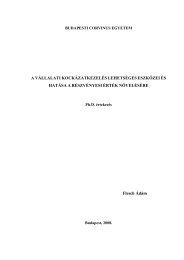THESES OF PH.D. DISSERTATION Barbara JENES
THESES OF PH.D. DISSERTATION Barbara JENES
THESES OF PH.D. DISSERTATION Barbara JENES
You also want an ePaper? Increase the reach of your titles
YUMPU automatically turns print PDFs into web optimized ePapers that Google loves.
2. Theoretical background<br />
The dissertation is built upon several theoretical pillars. It addresses the issues of country<br />
image and its dimensions as well as those of country branding. Moreover it discusses several<br />
considerations on questions of measuring and methodology and introduces destination choice<br />
into its framework as an output (behavioral) variable for the study of interaction effects.<br />
The framework of the empirical study is given by a synthesis of the above. The author strives<br />
to consolidate the different theoretical models by presenting their commonalities and also by<br />
including and studying all the factors that the literature agrees on being determining.<br />
From the field of the study of country image the conceptual distinctions, dimensions and<br />
measurement and methodological issues are being treated. Three major concepts have to be<br />
distinguished within a study on country image: (1) Product image (PI), (2) Country image<br />
(CI) and (3) Country of origin image (COO or CoI). According to the above, one can find<br />
three main types of country image definitions: (1) general definitions of country image, (2)<br />
product-country image definitions and (3) definitions of product image related to a country.<br />
The first group is that of overall country image (CI). The definitions thereof build upon the<br />
main aspects of the formation of a country image. They claim that a country image is an<br />
overall effect of a country’s economic, political development, cultural, historical traditions<br />
and other factors. (see e.g. Bannister – Saunders, 1978; Desborde, 1990; Allred et.al., 1999).<br />
We delimited the area of country image in general as a starting point for the present<br />
dissertation.<br />
As to the dimensions of country image, the following elements can be referred to as the main<br />
dimensions (according to the content analysis of relevant literature): (1) economy, (2) politics,<br />
(3) history, (4) culture, (5) geographical attributes, (6) people, (7) resemblance, (8) feelings.<br />
One can define the following as sub-categories: (i) job market (in connection with the<br />
economic dimension), (ii) international relations, conflicts (in connection with the political<br />
background), (iii) environment (in connection with the country’s geographical attributes).<br />
The first five dimensions (economy, politics, history, culture, geographical attributes) can be<br />
referred to as cognitive elements whereas the remaining dimensions (the evaluation of and<br />
resemblance to a country’s inhabitants, feelings) are the affective dimensions of the country<br />
image.<br />
Literature on country as a brand strongly relies on consumer-based brand equity approaches<br />
(Aaker, 1991, 1996; Keller, 1993) and indirectly on the associative network memory model<br />
(Anderson, 1990, 1993). This latter stems from the field of cognitive psychology and was<br />
already used by Keller (1993) to develop the original brand equity model. According to<br />
Anderson (1993, in: Pappu-Quester, 2010, p. 277.) cosumers’ memories store information<br />
hierarchically in a node-link structure, where, in some cases, to a given piece of information<br />
given associations would be joined. Accordingly, information about a country will lead to<br />
6

















